This was published 6 years ago
Tips on eating in Osaka, Japan: Where to find the best food
By Keith Austin
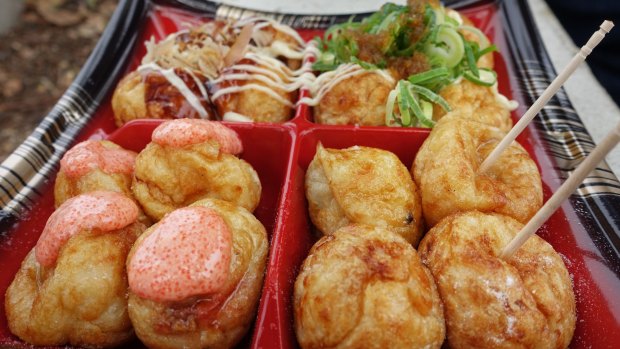
tTakoyaki (squid dumplings) in Osaka.Credit: Alamy
There is something deeply troubling about watching someone prepare okonomiyaki in front of you. This savoury pancake is hugely popular in Osaka and available pretty much everywhere. It's not going to win a culinary award any time soon but it's good hearty tucker.
The name comes from the word okonomi (how you like) and yaki (grill) and the pancake itself is essentially a base of batter and cabbage topped with bonito flakes, a sweet caramel-looking sauce and mayonnaise. Meat and/or seafood can be added "how you like". It's cooked on a griddle at the table in one of those feats of foodie theatre and legerdemain at which Japanese chefs excel. What it isn't is pretty. It's like watching someone cook up a giant cowpat. Luckily, it doesn't taste like one.
We are in the Namba district of Japan's third largest city, filling our faces in one of the Tsuruhashi Fugetsu okonomiyaki restaurant chain's premises (the one opposite Captain Terry Coffee Stadium). About an hour later, the five of us fall out of there heavier by two huge pancakes, a Japanese omelette, a pile of seafood noodles, eight beers and a Coke – and lighter by about $20 each.
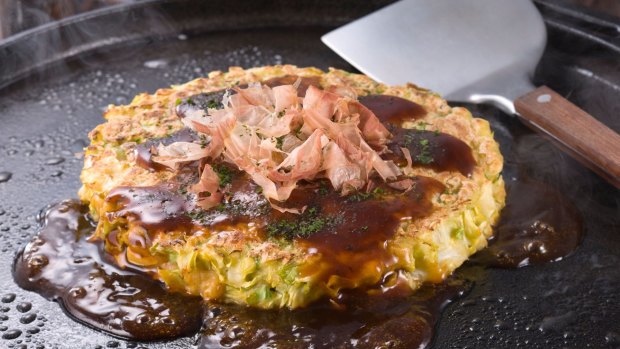
Okonomiyaki – Japan's hugely popular take on a savoury pancake.Credit: Alamy
Another popular street snack in this most food-loving of cities in food-loving Japan is takoyaki, little wheat flour-based batter balls that are filled with minced or chopped octopus, pickled ginger and shallots, and then cooked in special cast-iron moulded pans.
We try them at Takoyaki Dotonbori Kukuru in Dotonburi, Osaka's bustling, neon-lit food district. It's pretty easy to find because of the enormous yellow-eyed octopus curled menacingly around the outside of the shop.
The takoyaki come packed in a small cardboard box and are drizzled with a combination of a sort of Worcestershire sauce, the seemingly ubiquitous mayonnaise and dried bonito. The toppings can differ from stall to stall but the one constant to be aware of is that these little spheres are volcano hot inside. If you don't burn a hole in the roof of your mouth you'll find that they're crisp on the outside but with a soft and oozing, dough-like centre. We stand in the street to eat them and end up sounding like the aftermath of an unsuccessful fire walk. They're nice, like arancini balls filled with a fishy lava.
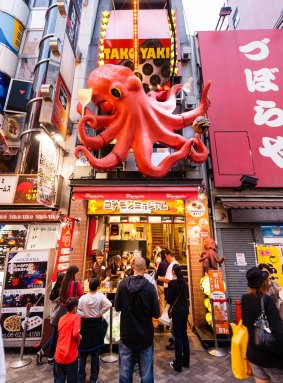
Takoyaki restaurant in Osaka.Credit: Alamy
On our first night in Osaka we headed for the hip Temma district and a small yakitori restaurant which our guide found by asking for recommendations at a local bar. This is how we came to be sitting in Mame (Bean) restaurant with free beer. For, in the time between the advice and our arrival, the man who had proffered said advice had slipped into the restaurant and paid for a round of drinks. So let me say "kanpai, Uryu-san", whoever you are. This is not unusual, says our guide. Richard Farmer is an Englishman who has lived and worked in Japan for many years and is pretty much fluent in the language. "The people are just so friendly here," he explained. "I've known people who are lost get help from a local who will hail a taxi, get in with them, take them where they're going and then pay for the taxi."
Such largesse doesn't extend to our complementary appetiser, which our waitress slid on to the table without asking if we wanted it. This is shio-kyabetsu and it is as moreish as all get out. Simply cabbage leaves mixed with salt and sesame oil and sprinkled with sesame seeds, it works wonderfully with a cold beer and should be taken up in every pub in Australia forthwith.
It is not, however, complementary. We will, explains Richard, be charged about 300 yen ($3.50) for it. It's just part of the culture. As is never tipping and a sneaky 8 per cent tax which gets added at the end of the meal and catches out many a tourist. Swings and roundabouts.
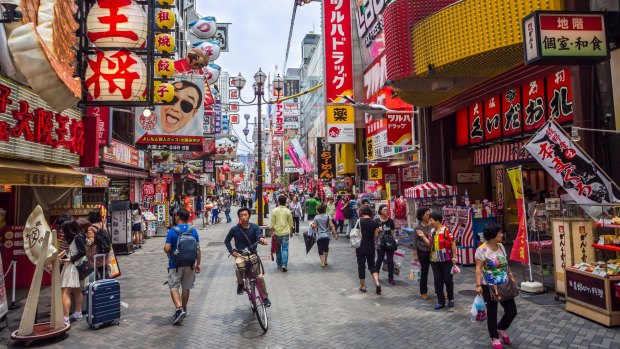
Dotombori Area, Osaka.Credit: Alamy
We got to Mame through a warren of narrow, shadowy lantern-lit streets and alleyways where many small izakaya restaurants and bars serve drinks and tapas-style dishes. Mame, for instance, was packed. Yes, there were a good 14 people in that night and if anyone else had come in they'd have had to sit on my lap, and probably lost an eye to a badly wielded chopstick.
(A warning: what follows next might be distressing for some vegetarian readers.)
We ordered fried noodles with beautifully moist chicken and shredded chilli, chicken meatballs with grated radish, chicken thigh skewers wrapped in perilla (shisho) leaf and topped with a pickled plum paste, grilled rice balls with tuna flakes, tempura, mushrooms, grilled brussels sprouts and chicken neck skewers. So, if you were in Osaka in February this year and couldn't get chicken for love nor money, you know why.
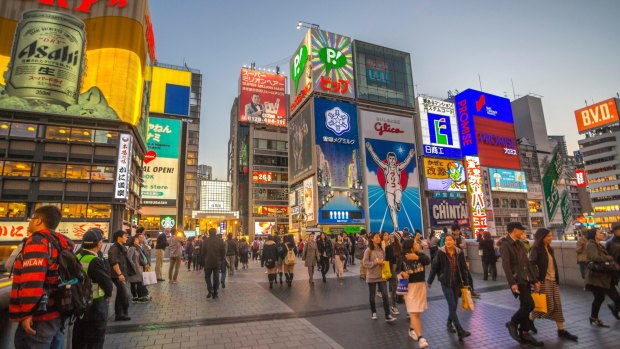
Downtown Osaka.Credit: Alamy
The Japanese are possibly the politest, most etiquette- and rule-bound people on the planet but if there's one thing that gets them riled up it's double-dipping at a kushi-katsu restaurant. Kushi-katsu is essentially skewers of meat or vegetables that have been battered and deep-fried. It's a little like tempura but with a different batter.
To try it we follow guide Richard out to Shinsekai (New World), a neighbourhood "created" in 1912 with, supposedly, New York and Paris as the design guides. Looking at it today, with its bright neon colours, shop windows full of plastic food and gigantic puffer fish outside fugu restaurants, you've got to wonder if sake and drugs were involved in the execution.
Richard says it's deemed to be rough and dangerous, a gritty magnet for the homeless and the destitute – and all just a stone's throw from, Abeno Harukas, the tallest skyscraper in Japan – but describes it himself as "slightly forgotten" and "in need of a refurb".
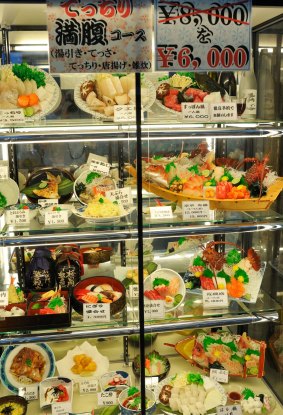
The menu on display at a seafood restaurant in Dotonburi, Osaka.Credit: Alamy
Thanks to his local knowledge we eschew the bright main streets for a small covered alleyway around the back and find ourselves squeezed into a tiny kushi-katsu … I think cafe or canteen might describe it best. Inside there is a long counter full of locals sitting shoulder-to-shoulder, eating, drinking (beer is pretty much de rigueur here) and, wonder of wonders, smoking.
Richard orders up a storm and we are inundated with skewers of everything from lotus root to pork, asparagus and onion. We also try dote-yaki, a popular dish of beef sinew stewed in miso and mirin – very much an acquired taste, it must be said. Dotting the long thin counter are stainless steel containers filled with a gnarly-looking soy sauce which is shared between all the customers. From what I can gather, a double-dip means you go straight to hell.
The meal is nice enough – soul food rather than health food, says Richard – but the real attraction is the journey. There aren't too many places where you can tug on marinated beef sinew while drinking cold beer and sucking in the cigarette fumes from the bloke sitting next to you. Frankly, I loved it, even if I'm still picking bits of dote-yaki out of my teeth as you read this.
Keith Austin travelled as a guest of Inside Japan Tours and Qantas.
FLY
Qantas now flies direct from Sydney to Osaka's Kansai airport three times a week (Monday, Wednesday and Saturday) on an upgraded two-class Airbus A330. Return economy flights start from $859 while return business class seats start from $3159. Flights from Melbourne and Brisbane go via Singapore or Tokyo. See qantas.com
STAY
Inside Japan Tours chooses hotels based on the individual traveller's needs and budget. We stayed at the five-star, 1920s-style Imperial Hotel Osaka, right on the Okawa River, and the new Candeo Hotel in Osaka's Namba district. Nominally a three-star hotel, the Candeo opened in July 2017 and punches well above its weight. Visit the onsen on the 17th floor. It's pretty much the only place in the city where you can take in such amazing views totally naked. See imperialhotel.co.jp/e/osaka and candeohotels.com/namba
TOUR
Established in 2000, Inside Japan Tours offers small group tours, tailored self-guided adventures and cultural experiences in Japan. See insidejapantours.com
FIVE NON-FOODIE THINGS TO DO IN OSAKA
1. GO-KARTING
The first thing people ask when you tell them you went go-karting in Osaka dressed in a Super Mario onesie is "what, on the actual streets?". To which the answer is a resounding "yes". In and out of actual traffic on actual streets at night with lead driver Ume Chan. Such good fun and the closest you'll come to being a movie star – there's now a German tourist somewhere with a photograph of himself and … me. A passport and an International Driver's Licence are essential. See maricar.com
2. SPA WORLD
For the uninitiated, onsen are Japanese bath houses that are separated by gender. This faded building on the edge of the Shinsekai district is an onsen theme park with a water park on the roof. On the day I go, men are allowed in the European zone on the fourth floor. It's a sprawling, many-roomed area with themed spas (Greek, Spanish, Finnish, Ancient Rome and Atlantis, among others. There's a cafe and bar, too. See spaworld.co.jp/english
3. STROLL DOTONBURI
It's touristy, yes, but with good reason. Even if you're not here for the food, the area around the canal is worth a look for the sheer explosion of colour and people and lights and weird decorations such as the giant crab and huge puffer fish. Take time to explore the side streets. jnto.go.jp/eng/regional/osaka/dotonbori.html
4. HELL TEMPLE
Senko-ji is a fascinating look at Buddhism's idea of hell. Outside is a sign that features a devil saying "If you tell a lie I will pull out your tongue". Inside, if you insert your head into a hole in a stone, you are said to be able to hear the sounds of hell. I heard Justin Bieber. No lie. The main hall here dates from 1661. Hell temple is just a short walk from Hirano station.
5. KOJI KINUTANI TENKU ART MUSEUM
Take the elevator to the 27th floor of the distinctive Umeda Sky Building to experience the amazing art of Kansai native Koji Kinutani. No, I'd never heard of him either but this is stunning stuff. Divided into two areas – a European-inspired red zone and an Asian-focused blue zone – the permanent exhibition features 3D visuals, paintings and sculptures. Nearest comparison? Reg Mombassa's more serious Asian cousin. Don't like art? Go for the cafe and the views at sunset. kinutani-tenku.jp/en
Sign up for the Traveller Deals newsletter
Get exclusive travel deals delivered straight to your inbox. Sign up now.